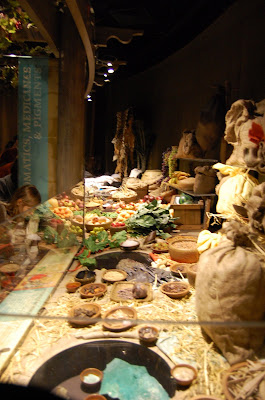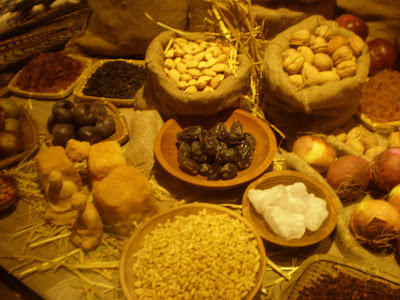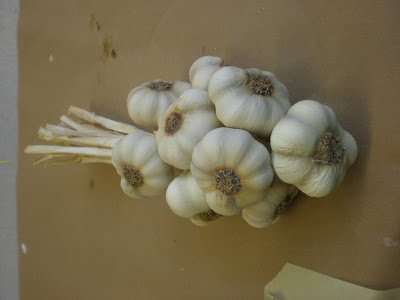


















photos by Christopher Luxem
 This is a photo of the head before I cleaned it or did anything else to it. I dusted using a rubber dust pick up and an air hose. I cleaned all the sculpted parts with alcohol.
This is a photo of the head before I cleaned it or did anything else to it. I dusted using a rubber dust pick up and an air hose. I cleaned all the sculpted parts with alcohol. Next, I used a dremel to get rid of the sculpted parts that were breaking, cracked, or sticking out in weird ways. I also drilled out new nose holes. Not too deep, of course!
Next, I used a dremel to get rid of the sculpted parts that were breaking, cracked, or sticking out in weird ways. I also drilled out new nose holes. Not too deep, of course! Then I airbrushed everything I re-sculpted. I tried not to take away too much from the vintage look of the rug, so I didn't do major surgery on this guy. I didn't want to have to take off the nose or mouth or eyes completely. I think that the look and feel of this guy is important. He had crazy eyes to begin with, so I just made sure to make them a bit more even, but not change them entirely.
Then I airbrushed everything I re-sculpted. I tried not to take away too much from the vintage look of the rug, so I didn't do major surgery on this guy. I didn't want to have to take off the nose or mouth or eyes completely. I think that the look and feel of this guy is important. He had crazy eyes to begin with, so I just made sure to make them a bit more even, but not change them entirely. A 3/4 view. All airbrushed.
A 3/4 view. All airbrushed.




 The Marketplace scene!
The Marketplace scene!



 The ship, with the pots I worked on.
The ship, with the pots I worked on.
 I sculpted the camel's fur back on once the head was attached to the neck. I also applied the hair in the photos above.
I sculpted the camel's fur back on once the head was attached to the neck. I also applied the hair in the photos above.
 The camels are taking over.
The camels are taking over. I painted these garlic
I painted these garlic Then made them into a rope!
Then made them into a rope! 
 Oregano before
Oregano before Oregano after I painted it
Oregano after I painted it Oregano finished!
Oregano finished! One of four camels, fresh out of the mold. Each piece needs 2 layers of "gel", 2 layers of fiberglass resin (laying the fiberglass then wetting it down with stippling a brush over it) and then an edge layer of more fiberglass (then wet) then a gel to seal the edges. So, each piece gets about 9 layers before we can close it up. We hang it upside-down to set it so it doesn't collapse inside the mold.
One of four camels, fresh out of the mold. Each piece needs 2 layers of "gel", 2 layers of fiberglass resin (laying the fiberglass then wetting it down with stippling a brush over it) and then an edge layer of more fiberglass (then wet) then a gel to seal the edges. So, each piece gets about 9 layers before we can close it up. We hang it upside-down to set it so it doesn't collapse inside the mold. One layer of gel-like polyester resin.
One layer of gel-like polyester resin. The mold, taken apart. There are about 15 pieces total.
The mold, taken apart. There are about 15 pieces total. The large abdomen piece.
The large abdomen piece. Another view.
Another view. Pots - replicas from a sunken ship thought to be from the silk road era(s). These are cast in smooth cast and these few are broken open. I sanded the edges of the break to make it look more like a ceramic break. I also chased seams, and sealed bottoms on a lot of these pots. There will be 50-75 total. There are 30 now, 1/2 finished. A long way to go.
Pots - replicas from a sunken ship thought to be from the silk road era(s). These are cast in smooth cast and these few are broken open. I sanded the edges of the break to make it look more like a ceramic break. I also chased seams, and sealed bottoms on a lot of these pots. There will be 50-75 total. There are 30 now, 1/2 finished. A long way to go.

 Unpainted Rhubarb. I sculpted the two parts together. The leaves are vacu-formed plastic to plaster molds of leaves, and the stems are cast from real rhubarb stems.
Unpainted Rhubarb. I sculpted the two parts together. The leaves are vacu-formed plastic to plaster molds of leaves, and the stems are cast from real rhubarb stems.

 Kohlrabi - bulbs cast from real vegetables, leaves vacu-formed and in this picture, I am grafting them together.
Kohlrabi - bulbs cast from real vegetables, leaves vacu-formed and in this picture, I am grafting them together. Indian gooseberries - I sculpted these, Steve helped me cast them, then I painted them.
Indian gooseberries - I sculpted these, Steve helped me cast them, then I painted them.  1/2 painted gooseberries.
1/2 painted gooseberries. Peepul figs - same process as the gooseberries.
Peepul figs - same process as the gooseberries.